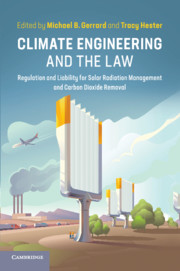
While climate engineering is the last resort for dealing with the challenges of climate change, it is one that states must be prepared to consider as the effects of unchecked CO2 emissions become increasingly untenable. This premise has motivated a new collection of articles by environmental law experts. If states do not take preemptive action, the book argues, they risk rogue actors attempting to engineer large-scale changes unilaterally by, say, spraying aerosols into the atmosphere to decrease the amount of sunlight we receive (“albedo modification”) or dumping iron filings into the ocean (“ocean fertilization”) to hasten the growth of carbon-sequestering algae. The collection offers a legal playbook for heading off worst-case climate scenarios, ones that would have seemed outrageous only a few years ago but are appearing more and more realistic.
While the collection’s scope is global, its focus is on strategies that people are already beginning to consider or test in the United States. It explores the current legal frameworks that might support or challenge the two main approaches to climate engineering—solar radiation management (SRM) and carbon dioxide removal (CRM). One by one, the book offers clear, brief explanations of the actions people are already taking, the scientific evidence supporting or challenging such interventions, the areas of global environmental law that might apply, and what might be the least resolved issue, namely, the relationship between available scientific research and the claims of climate engineers. The writing is plain enough to brief a lay person on the technicalities of climate engineering and relevant international agreements. At the same time, the chapters are well-cited and thorough enough to guide scholars interested in deeper exploration.
By its conclusion, the book moves from its initial agnostic stance toward the view that climate engineering is inevitable. Still, the collection reads as evenhanded; those hoping for a definitive position on the legalities of climate engineering will be unsatisfied, since the question has yet to be tested in the courts. The contributors do an excellent job of laying out the arguments international lawyers are likely to use on either side of the question and suggesting how an international agreement on climate engineering might clarify existing ambiguities.
